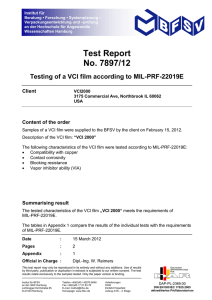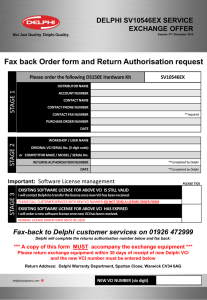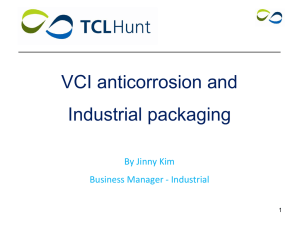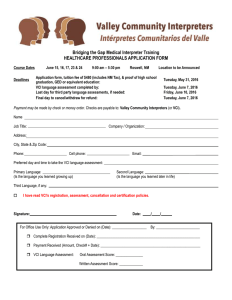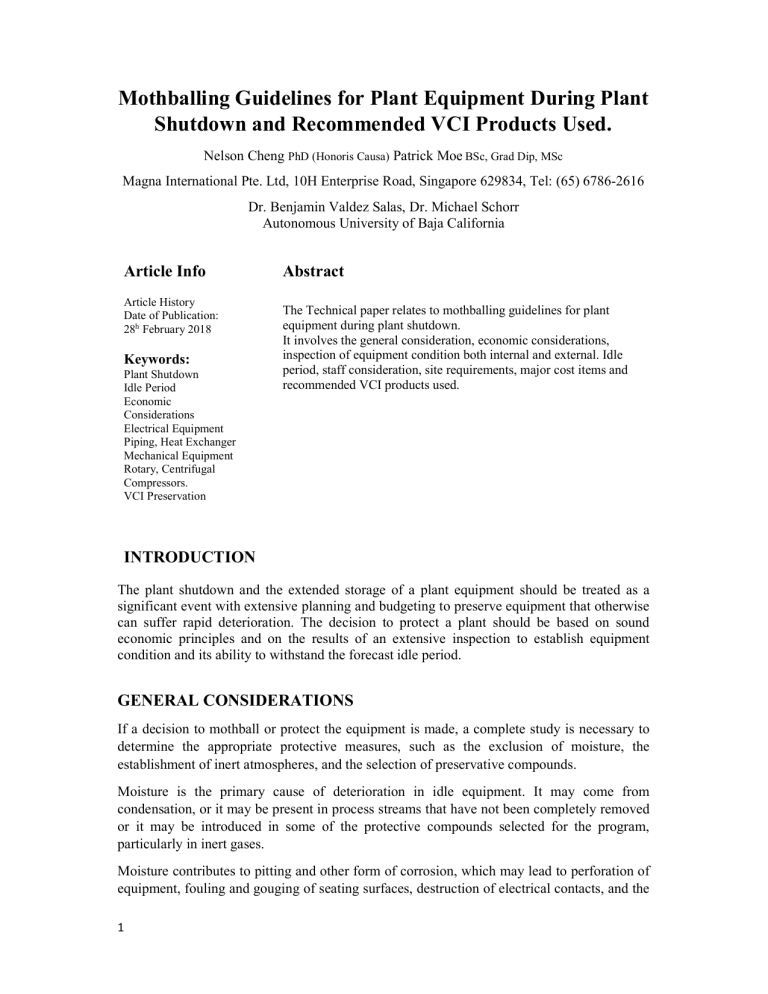
Mothballing Guidelines for Plant Equipment During Plant Shutdown and Recommended VCI Products Used. Nelson Cheng PhD (Honoris Causa) Patrick Moe BSc, Grad Dip, MSc Magna International Pte. Ltd, 10H Enterprise Road, Singapore 629834, Tel: (65) 6786-2616 Dr. Benjamin Valdez Salas, Dr. Michael Schorr Autonomous University of Baja California Article Info Article History Date of Publication: 28h February 2018 Keywords: Plant Shutdown Idle Period Economic Considerations Electrical Equipment Piping, Heat Exchanger Mechanical Equipment Rotary, Centrifugal Compressors. VCI Preservation Abstract The Technical paper relates to mothballing guidelines for plant equipment during plant shutdown. It involves the general consideration, economic considerations, inspection of equipment condition both internal and external. Idle period, staff consideration, site requirements, major cost items and recommended VCI products used. INTRODUCTION The plant shutdown and the extended storage of a plant equipment should be treated as a significant event with extensive planning and budgeting to preserve equipment that otherwise can suffer rapid deterioration. The decision to protect a plant should be based on sound economic principles and on the results of an extensive inspection to establish equipment condition and its ability to withstand the forecast idle period. GENERAL CONSIDERATIONS If a decision to mothball or protect the equipment is made, a complete study is necessary to determine the appropriate protective measures, such as the exclusion of moisture, the establishment of inert atmospheres, and the selection of preservative compounds. Moisture is the primary cause of deterioration in idle equipment. It may come from condensation, or it may be present in process streams that have not been completely removed or it may be introduced in some of the protective compounds selected for the program, particularly in inert gases. Moisture contributes to pitting and other form of corrosion, which may lead to perforation of equipment, fouling and gouging of seating surfaces, destruction of electrical contacts, and the 1 deterioration of buildings and other structures. It can be controlled through the use of a dew point level for the atmospheres inside equipment so that condensation will not occur even at lowest ambient temperature the equipment will experience. For short shutdown periods, frequent draining of equipment may reduce the moisture level sufficiently to prevent serious corrosion. Damaged insulation can result in heavy corrosion due to the ingress of moisture from rain or snow. Proper sealing of insulation is necessary particularly in marine or industrial environments. Heating is recommended, of course, for the protection of buildings and of electrical components. In many instances, electrical equipment has its own heaters, which must be continuously energized to prevent damage. Inert atmospheres may be employed to preclude the presence of moisture and/or oxygen. The inert atmospheres must be dry and free from harmful contaminants. Nitrogen is the inert atmosphere most commonly used. However, its effects on various scales and sludge found in a plant must be assessed. Sludge and scales found on in most of plant frequently contain compounds that combine with oxygen or moisture to produce harmful acids. These acids may promote rapid corrosion and cracking of common construction materials. Neutralization of these sludge and scales using a gas such as ammonia or a solution such as sodium carbonate may be necessary. Since short shutdown periods may not require neutralization it is essential to determine how long a sludge or scale can be exposed to oxygen or moisture before harmful corrosive compound are formed. Oil may be used to protect equipment, particularly in refineries with abundant supplies. The oil should be free of contaminants, such as hydrogen sulphide, that can promote corrosion. However, provision must be made to ensure that the oil is not drained off and sold, particularly during the period of rising oil prices. ENCONMIC CONSIDERATIONS The decision to shut down am operating facility and protect the idle equipment is never made easily. In many instances, equipment experiences an extended idle period before a decision to protect it is reached. Severe deterioration may result due to corrosion from the general environment and from scales or deposits, which can be protective under operating conditions but corrosive during shutdown. Consequently, the sooner a decision is made to clean and protect the better the chance of successful restart. A decision to mothball assumes that the plant is worth preserving in the first place- a conclusion that depends on the answer to the following questions: What are the financial prospects for the company now and in the future? 1. Is the market for the product likely to recover? 2. Will the cost of preserving the equipment exceed its future replacement protection? 3. Can the unit be protected or does its design preclude any chance of successful protection? 4. Can the equipment last for the duration of the protection period? 2 EQUIPMENT CONDITION The condition of the equipment must be determined by a complete and thorough inspection relying on past history to identify potential problems areas. This inspection should indicate: Internal Inspection Pumps, compressors, motors, fans etc. should be examined both internally and externally, as applicable, to determine their condition and suitability for protection. A complete visual inspection of the interior of all process equipment and vessels is recommended after any necessary cleaning. Sweetening, steam cleaning, or other neutralizing steps may be required for vessel entry. Any problems found should be identified and repair techniques outlined, Nondestructive evaluation techniques such as ultrasonic or radiography are useful on a spot basis to verify vessels condition. Sludges and scales should be analyzed to assess their effect on protection capabilities. Exterior Inspection Examination of components for exterior corrosion should be performed, particularly of those that may be affected by wet insulation. Examination of insulation is necessary to determine whether or not it should be removed or can be repaired. The condition of heat tracing should be assessed. Mechanical Equipment Pumps, compressors, motors, fans etc. should be examined both internally and externally, as applicable, to determine their condition and suitability for protection. Electrical Equipment Electrical equipment is usually in reasonably good condition. However, this must be established through thorough inspection. Structural Structural members should be thoroughly inspected. This includes such items as tower an exchanger bases, anchor, bolts, pipe racks, cooling tower and all forms of support plus the protection (normally paint) that has been applied. Piping Piping, particularly small diameter components, is perhaps the most difficult items to assess. It is usually insulation ad there are untold miles of it in plants. Inspection frequently involves 3 the complete assessment of large diameter members (over 24” is a convenient break point) including removal of insulation, spot radiography, valve removal to permit internal inspection, and ultrasonic thickness measurements. Piping less than twenty-four inches in diameter may be completely inspected or may be inspected on a sample basis depending on its importance to plant operations. For plants with predominantly small diameter piping, personnel will inspect everything over two inches in diameter. Piping two inches and less in diameter will generally abandoned unless it is critical to the operation. High-alloy piping, lined piping system and those constructed of other that may be expensive or be long delivery items are usually inspected thoroughly, following cleaning and drying. Small diameter piping is examined on a sampling basis with the critical nature if the line determining the attention paid to it. Of course, the maximum diameter of the line chosen as a cut-off for complete inspection varies from plant to plant. A complete inspection of the plant is therefore the first major cost item to be associated with a mothballing program. It may represent anywhere from 0.1 to 1.0% If the capital cost if the equipment depending on the extent to which in-house personnel or contract personnel are used. IDLE PERIOD If the equipment is worth preserving, the next step is to determine the probable shutdown period. The length of this period affects every aspect of planning and costs because the longer the equipment is idle, the more protection is required. An inaccurate prediction of idle time will affect the cost of maintaining the equipment and the ability to restart in the future. In fact, underestimating the idle period is not only the most common complaint associated with mothballing but also is responsible for the greatest deterioration in shutdown plants. This is illustrated by the history of a chemical plant that was shut down initially for a three months period. Market conditions did not improve and the plant shutdown was extended in three months increments for approximately three years. Short-term protection was applied at the end of each three-month period. When start-up was approved, it was found that the cost of protection and equipment replacement amounted to six times the anticipated cost of a program designed for a 1 ½ year-to-five-year period. Plants protection with short-term preservatives almost always remain idle much longer than the original forecast period. Consequently, a review of market conditions and preservation costs after a one-year idle period is recommended. If start-up is not foreseen for at least another year, upgrading the protection to the eighteen-to-sixty months program is advisable, particularly on critical or long delivery items. The protection programs are generally divided into three categories: 1-18 months, 19 monthsto-five years and over five years. Obviously, a plant is not going to disintegrate at 19months; however, the periods do reflect the life expectancies of various protection methods so that extension beyond the established time generally involves reapplication of preservatives. A general “rule of thumb” establishes costs for programs as: 4 1-18 months 19 months-to-five years greater than five years - 1.0 2.5 4.0 Preservatives to be applied for longer protection period generally require better metal surface preparation, with sandblasting common. Restrictions on such cleaning method may dictate the protection program chosen. The success of a protection program may depend on the quality and detail of the protection instructions and procedures. Obviously, the more detailed the procedure the less likely something will be overlooked, e.g. The thickness of protection coatings. Considerable engineering time will be spent on the preparation of a protection program once the idle period has been established. It will be necessary to prepare detailed procedures and field instruction for the protection of each category of equipment. A contractor should leave no detail to interpretation. The procedure for conducting each operation should be described in complete detail, step by step. Acceptance and rejection criteria must be outlined as well. Close inspection of the application of the preservatives is necessary. A properly applied compound may protect for years but a poorly applied one may cover problems, which will show up long after the contractor has left, requiring costly repairs. The importance of responsible supervision of the work cannot be overemphasized. EXPERIENCE AT OTHER PLANTS Based on experience gained at plants being mothballed, a number of problems may be avoided through the judicious use if manpower. Some of these considerations are listed below. Staff Considerations During short-term shutdown-one lasting six months or less- it is unlikely that personnel would be laid off. Preservation work may be done by these personnel as they have a vested interest in maintaining the plant. If there is to be a layoff for linger term shutdowns. Plant personnel should not be involved in the protection work as they tends to make the job last as long as possible. Sabotage is quite common, as is theft. Experience indicates that only staffs who are to continue at the plant should be involved in its protection. Otherwise, contract personnel should be hired to do the work while inspection of the application of the mothball compounds should be done by those responsible for maintaining and inspecting the plant after shutdown. Safety aspects must be considered including security guards and sufficient personnel to maintain a fire crew on site, where required. 5 Site Requirements Electricity, heat and water for fire-fighting are necessary to maintain certain mothball and safety aspects. The costs involved must be forecast and form part of any economic evaluation. Similarly, maintenance of an inert atmosphere will involve replenishment of the gas, as leaks are almost inevitable. Road clearance under winter conditions may be necessary in northern climates. Brush and grass control will be necessary as well. Insurance may be a major cost item, particularly if the plant will maintain a large inventory of flammable products. MAJOR COST ITEMS – MOTHBALL PROGRAM 1 2 3 4 5 Complete inspection of plant or unit to establish condition. Selection of preservative based on predicted idle period. - cost of equipment preparation - cost of preservatives and application - cost of reapplication as necessary Preparation of a comprehensive mothball program. -preparation of procedures and specifications Application of the protection program. -Contractors or plant personnel -Inspection of the application Monitoring of the system. -inspection personnel -2 mechanical/ production or process -1 electrical -security (must have adequate fire-fighting crew) Other costs. -insurance -electricity -heat WHAT EQUIPMENT SHOULD BE PROTECTED Although equipment in a chemical plant or refinery represents a considerable capital investment, it may be impractical to protect it all during an extended shutdown period. Some equipment is relatively inexpensive and protection methods can result in considerable expenditures. Nonetheless, in order to maintain the integrity of the rest of the plant. Plant personnel will decide what is critical and what is not. The following have been used as general guidelines during the mothballing of facilities. Field Erected Equipment All major equipment such as tower, cracker, sphere bullets and storage tanks are generally considered worth protecting due to the cost involved in building these relatively large structures. The amount of protection varies with the complexity and value of the item. Storage tanks, for instance, may be protected simply by draining or they may be coated with 6 oil. Tower and spheres probably will be protected with inert atmospheres. Insulation is extremely important on this equipment as considerable time is involved in its application o removal. Still it towers and spheres are to be stored beyond three years, insulation removal should be considered. Heat Exchangers Heat exchangers are generally considered as a separate item both because of their numbers in most plants and because of their complexity. Heat exchanger protection includes cleaning followed by thorough drying. (These steps are critical to the success of the operation as any deposits or moisture may establish conditions for accelerates corrosion). Exchanger geometry such as fixed tube-sheets, floating tube-sheets, multiple-pass units, the U-bend in tubes and even dissimilar metal construction all complicate the protection equation. As well, the gap between flanges, flange faces and sealing surfaces must be protected to avoid costly reworking prior to restart. Mot heat exchangers are protected with an inert atmosphere on the inside. Banks of exchangers in a unit lend themselves readily to this technique. It also permits protection of the interconnecting piping which is often complicated. In addition, flange faces are protected with gasketing compound to prevent crevice attack and the gap between flanges may be filled with protective compound although both procedures are costly and time consuming. Bolting can be protected in the same manner, although some facilities consider the replacement of all bolting prior to start-up as routine. Insulation again is of prime concern for it is rarely moisture-proof and without operating temperature to keep it dry very rapid attack can result, particularly in climates subject to large temperatures to between day and night. Insulation removal and exchange painting is normally suggested for storage of more than three years. Austenitic stainless-steel construction does afford considerable protection in units of these materials. Here, the major concerns are crevice corrosion between flanges, stress corrosion cracking or intergranular corrosion due to inadequate neutralization, or cracking due to wet insulation. Maintaining heat tracing may help to alleviate problems related to the insulation but it also may cause increased corrosion due to concentration effects caused by boiling of solutions. Extreme care must be used if heat tracing is to remain on. Piping Piping presents the most difficult protection problem in a plant because of the great quantities, varying size and the condition of the insulation. In most plant, large diameter, expensive piping is protected internally with inert atmospheres after flushing, draining and drying. Small diameter piping, unless it is essential to maintain an inert atmosphere, is not protected other than to flush it and drain it, drain valves are generally left open. 7 The size of pipe that constitutes the cut-off between protection and non-protection varies from plant to plant –24” in several facilities, 12” in some and as small as 2” in others. Economic dictates the protection afford as it is relatively easy to procure small- diameter, carbon steel pipe although installation can be expensive. Underground piping presents additional problems. If it is cathodically protected the system should be maintained and inert atmospheres used internally. Buried piping that can be easily replaced is frequently abandoned. Piping in trenches presents another problem as trenches tend to fill with water, creating serious external corrosion. This piping is also frequently abandoned in favor of new construction at start-up. Pipe insulation is particularly bothersome again due to the sheer volume of it. Moisture ingress at hanger, flanges or other breaks in covering can promote very rapid corrosion. Fired Heaters Fired heaters are generally protected through the use of heat, desiccants, inert atmospheres and protective compounds. These heaters are relatively large expense items and their protection is comparatively easy. protected through the use of heat, desiccants, inert atmospheres and protective compounds. These heaters are relatively large expense items and their protection is comparatively easy. Boilers and Associated Equipment Boilers, which represent a large capital outlay, are designed to operate many years. Even very old boilers can operate efficiently so protection is usually elaborate and complete. Boilers may be stored dry or wet. Dry storage is usually utilized when shutdown is to exceed one year while wet is used for shorter periods or when the boilers may have to be brought back on line relatively quickly. Dry storage involves the use of desiccants, oils, vapor phase inhibitors and preservation greases. Wet storage utilizes some heat and oxygen scavengers with or without corrosion inhibitors. Mechanical Equipment Most large pumps, compressors, blowers, fans, extruders and their associated seal and lubricating systems are protected, frequently in place, although they may be disassembled instead. Casting, valves, rotors, etc. are coated with various protection compounds, and oils are circulated through the systems. Rotors are usually turned once a month to protect bearings and shaft bearing surfaces. 8 Reactors, Mixers, Autoclaves The vessels are the heart of many processes and usually are protected. Many of these items are indoors so that protection, after cleaning, requires only coating of machined surfaces, and maintaining heat or providing an inert atmosphere. Electrical Equipment Electrical equipment such as motors, switchgear, relays etc. are generally protected. Motors may have their heaters activated and the rotors are turned once a month. Desiccants and vapor phase inhibitors are used in cabinets pr relays. Switchgear is generally coated with grease. Flare Systems If an inventory of flammable products is maintained in a plant, the flare system remains operational. If no inventories exist, the flare system is generally protected to the flare drums with an inert atmosphere following flushing, draining and drying. The stacks may be capped or they may be left open. Some facilities have attempt an inert atmosphere blanketing of the stack but gas losses tend to be high. EQUIPMENT NOT PROTECTED Small, inexpensive equipment is usually not protected due to the costs involved. This equipment includes: 1. Inexpensive instrumentation such as small pressure gages, level gages, small control valves, etc. 2. Small motors – experience suggests that it is uneconomical to protect motors of less than 10 hp. 3. Small tanks such as weigh tanks, small atmospheric storage tanks, waste treatment tanks and other components that can be replaced quickly and inexpensively. 4. Small pumps, blowers and fans that can be replaced readily. 5. Small diameter piping (2” and less) and cast-iron lines with the exception of fire water mains, large cooling water main and specialty-lined components. 6. Wood stave pipes and small FRP piping systems 7. FRP tankage that has been thoroughly cleaned and drained. COMPRESSORS Compressors, regardless of the alloy, are protected as if they were of carbon steel due to their high capital cost. Centrifugal or Rotary Compressors if this type may be protected in one of the following ways: 1. Close the suction and discharge valves. 2. Purge with nitrogen and maintain under a nitrogen blanket of 5 – 10 psig (0.034-0.069 MPa). 9 3. 4. 5. 6. 1. 2. 3. 4. 1. 2. 3. 4. 5. 6. 7. Fill all lubricating and seal-oil systems with Vappro 850 VCI oil additives. Bump the compressors over each month. Operate all lubricating and seal-oil systems for five minutes both before and after the compressor is bumped over. Coat external, machined surfaces with Vappro 868 VCI Wax. Erect a shelter over outdoor installations. - or Fill the casing with Vappro 850 VCI oil additives. Purge the casing with nitrogen and seal all openings. Coat exposed machined surfaces with Vappro 869 VCI Grease. Erect a shelter over outdoor installation. - or Remove the rotor, bearings, seals etc. Clean and coat the component with Vappro 869 VCI Grease and wrap with Vappro 826VCI film. Store the components in an indoor heated location in wooden crates. Block the rotor to prevent bowing or hang it vertically in storage. Blank off all lines with Vappro 826 VCI film and Vappro Foil tape. Fill the casing and oil systems with Vappro 850 VCI oil additives. Coat any exposed machined surfaces with Vappro 869 VCI Grease. Erect a shelter over outdoor installations. Reciprocating 1. 2. 3. 4. 5. 6. 7. 8. 9. 10. 11. 1. 2. 3. 4. 5. 6. 7. 10 Disconnect the suction and discharge piping from the process lines. Fabricate a short circuit pipe between suction and discharge nozzles. Operate the compressor against open suction and discharge for ten minutes. Install a sort circuit pipe and apply 5 – 10 psig (0.034-0.069 MPa) nitrogen at the media side. Maintain the nitrogen pressure during the shutdown period. Drain the cooling system and dry with hot air or nitrogen. Fill with Vappro 850 VCI Oil. Fill lubricating and seal-oil systems with Vappro 850 VCI oil additives. Operate the compressor ten minutes per month. Operate all lubricating and seal oil systems for five minutes before and after, as well as during, each compressor operation. Coat all exposed machined surfaces with Vappro 869 VCI Grease. Drain all tanks and receivers. Dry and for with Vappro 848 VCI Powder. Seal all openings. Erect a shelter over outdoor installations. - or – Drain the crankcase and refill it with Vappro 850 VCI Oil additives. Operate the compressor for ten minutes, then seal the crankcase. Purge the cylinders with nitrogen and maintain under a positive pressure of 5 – 10 psig (0.034-0.069 MPa). Drain the cooling system then dry it with hot air or nitrogen. Purge the cooling system with nitrogen and maintain under a positive pressure 5 – 10 psig (0.034-0.069 MPa). Coat all exposed machined surfaces with Vappro 869 VCI Grease. Drain all tanks and receivers. Dry them with warm air or nitrogen. Fog with Vappro 848 VCI powder and seal all openings with Vappro 826 VCI film. 8. 1. 2. 3. 4. 5. 6. 7. 8. 9. 10. 11. 12. Erect a shelter over outdoor installations. - or Drain the crankcase and refill it with Vappro 850 VCI Oil. Drain the cooling system; dry the systems with hot air or nitrogen. Purge the cooling system with nitrogen and maintain under a positive pressure of 5 – 10 psig (0.034-0.069 MPa). Remove all piston rod packing rings and oil wiper rings, clean them and coat then with Vappro 868 VCI Wax Coating. Wrap the rings in Vappro 826 VCI Film and store them indoors in a heated location. Remove the inlet and discharge valves from the cylinders; clean the valves and coat them with Vappro 868 VCI Wax Coating. Then wrap the valves with Vappro 826 VCI Film and store in an indoor heated; location in wooden crates. Remove the pistons and rods, clean them and coat them with Vappro 850 VCI Oil. Wrap the pistons and rods in Vappro 826 VCI Film and store in an indoor heated location in wooden crates. Spray the valves bores with Vappro 850VCI Oil. Fill the crankcase with Vappro 869 VCI Grease. Rotate the engine manually or through operation to thoroughly coat all components with Vappro 869 VCI Grease. Seal all nozzles. Coat any exposed machined surfaces with Vappro 869 VCI Grease. Erect a shelter over outdoor installations. NOTE: For breathing air and instrument air compressors, protection with an inert gas is preferable to prevent possible contamination with oil or other compounds. References: 1) Turnaround, Shutdown and Outage Management 1st Edition. Effective Planning and Step-by-Step Execution of Planned Maintenance Operations. Author: Tom Lenahan 2) Plant Maintenance Management Set by Anthony Kelly (Auth.). aacoa.net/bookinfo/plant-maintenance-management-set.pdf/ 3) Practical Shutdown and Turnaround Management for Engineers and Managers. IDC Technologies, Technology Training That Works. 4) Protection of Equipment During Storage, Standby and Decommissioning www.machinerylubrication.com/Read/448/equipment-storage-standby 11
